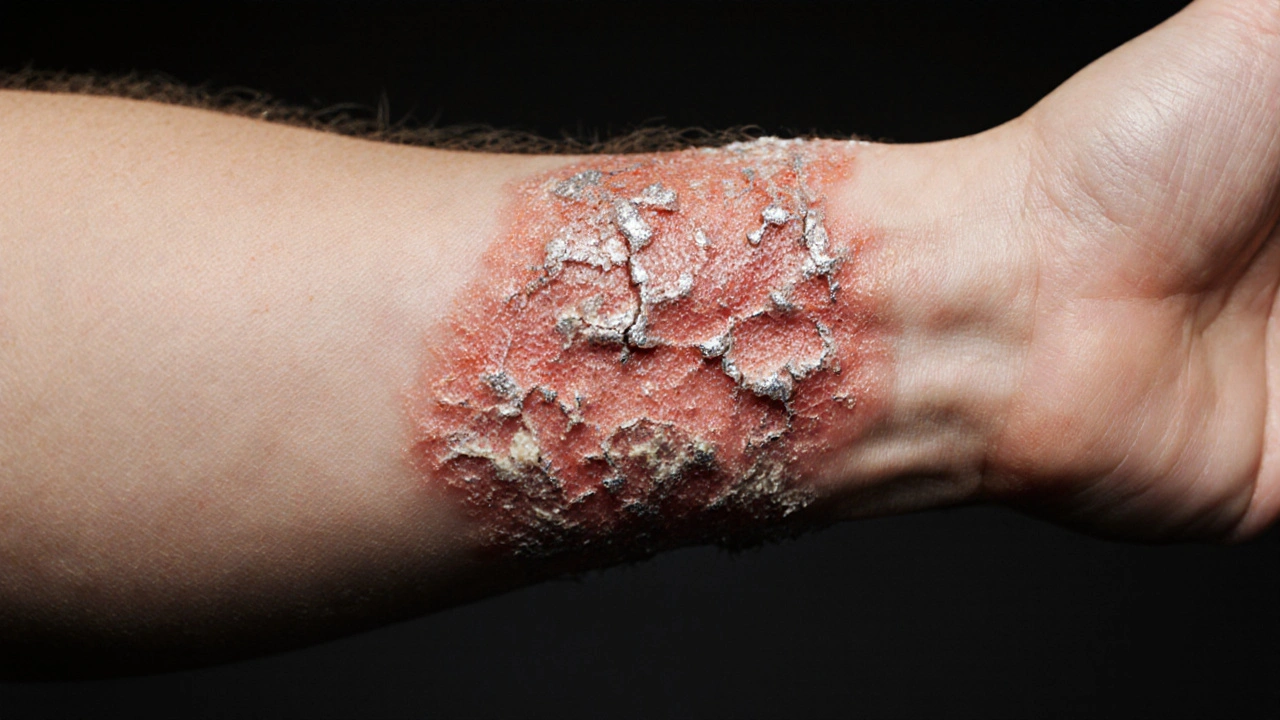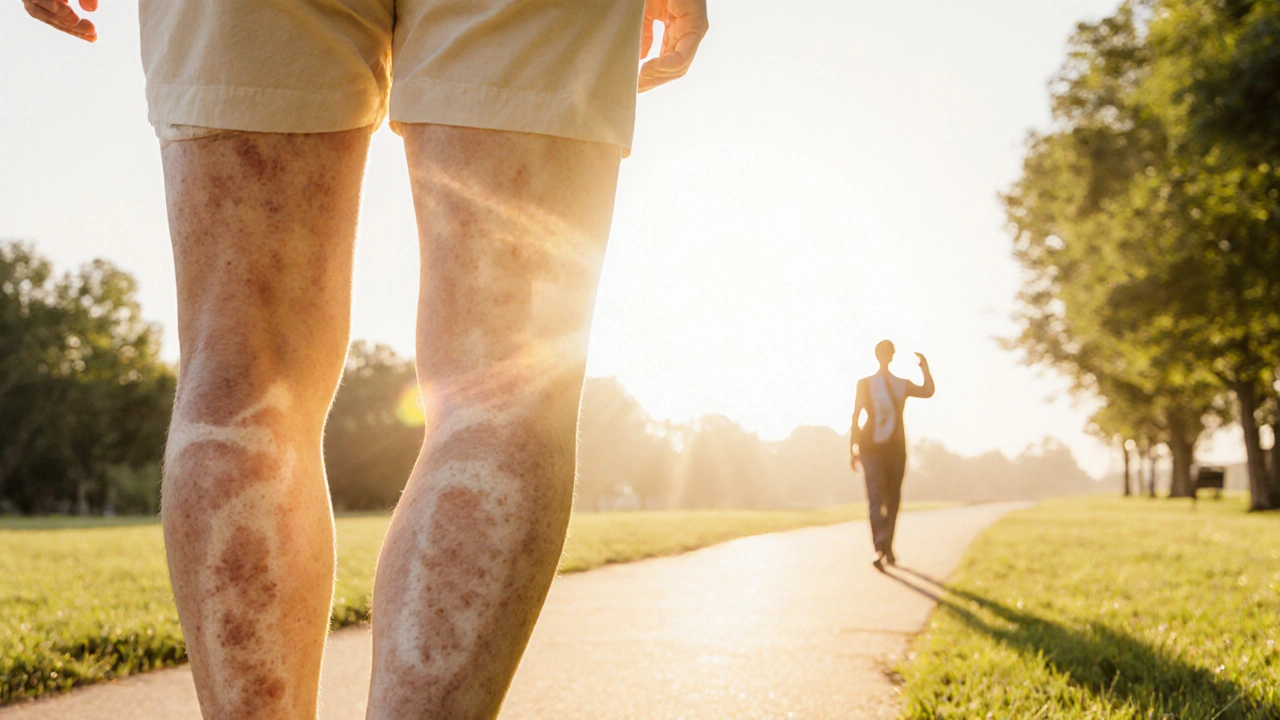Understanding Skin Pain in Psoriasis: Complete Guide

Psoriasis Pain Relief Calculator
How Severe Is Your Pain?
Rate your pain on a scale from 0 to 10 (0 = no pain, 10 = most severe pain)
Current Treatment Approach
Key Triggers Present
Living with itchy, burning patches can feel like an endless battle. If you’ve ever wondered why those red plaques hurt or how to stop the flare‑ups, you’re in the right place. This guide breaks down what drives skin pain in psoriasis, how to spot warning signs, and which tools actually work for relief.
What Is Psoriasis?
psoriasis is a chronic autoimmune skin condition that accelerates the growth cycle of skin cells, causing thick, silvery scales on the elbows, knees, scalp, and sometimes the whole body. The immune system mistakenly attacks healthy skin, releasing cytokines that tell skin cells to multiply 10‑40 times faster than normal. This rapid turnover creates the characteristic plaques and, often, a burning or stinging sensation.
How Psoriasis Leads to Skin Pain
Skin pain isn’t just a side effect; it’s a direct result of several intertwined processes:
- Inflammation: Pro‑inflammatory cytokines (like IL‑17 and TNF‑α) inflame nerve endings, turning a simple itch into a sharp or throbbing ache.
- Keratinocytes (the predominant skin cells) swell and crack the skin barrier, exposing nerve endings to the environment.
- Dry, cracked patches become entry points for bacteria, which can cause secondary infections and add a painful burning layer.
- Repeated scratching leads to micro‑trauma, further aggravating pain signals.
Common Triggers That Amplify Pain
Identifying triggers helps you stay ahead of the next flare. Below are the top culprits that most people with psoriasis report:
- Stress: Cortisol spikes boost cytokine activity, worsening both plaques and pain.
- Cold, dry weather: Low humidity strips moisture from the skin, cracking the barrier.
- Alcohol and smoking: Both increase systemic inflammation and slow healing.
- Certain foods: Nightshade vegetables, gluten, and high‑sugar diets can flare the immune response in susceptible individuals.
- Harsh skin products: Fragranced soaps, alcohol‑based cleansers, and exfoliants damage the barrier.
When Skin Pain Signals Psoriatic Arthritis
About 30% of people with psoriasis develop psoriatic arthritis, an inflammatory joint disease that often starts with painful skin lesions near joints. Watch for these clues:
- Stiffness or swelling in the fingers, toes, or spine lasting more than an hour after waking.
- Persistent heel pain (enthesitis) that isn’t linked to injury.
- New pain in a joint that wasn’t previously affected by skin plaques.
If you notice any of these patterns, a rheumatologist’s assessment can prevent long‑term joint damage.
Treatment Options to Relieve Pain
There’s no one‑size‑fits‑all answer, but most patients find relief by combining systemic therapy with smart skin‑care. The table below compares the most widely used approaches for pain associated with psoriasis.
| Treatment | How It Works | Onset of Pain Relief | Pros | Cons |
|---|---|---|---|---|
| Topical corticosteroids | Suppress local inflammation by inhibiting cytokine production | Hours to 2 days | Fast, inexpensive, easy to apply | Skin thinning with long‑term use, limited to mild‑moderate plaques |
| Moisturizers & barrier repair ointments | Restore lipid layer, reduce transepidermal water loss | Immediate soothing, full relief in days | Non‑prescription, safe for daily use | Doesn’t address underlying inflammation |
| Phototherapy (NB-UVB) | UV light slows keratinocyte proliferation and modulates immune response | 1‑2 weeks | Effective for moderate‑severe plaques, reduces pain | Requires clinic visits, risk of skin aging |
| Biologics (e.g., secukinumab, ixekizumab) | Target specific cytokines (IL‑17, TNF‑α) to halt autoimmune attack | 2‑4 weeks | High clearance rates, powerful pain reduction | Expensive, need injection, infection monitoring |
| Oral systemic agents (methotrexate, apremilast) | Suppress overall immune activity | 3‑6 weeks | Cost‑effective alternatives to biologics | Liver monitoring, possible GI upset |
Most people start with topical steroids and moisturizers, then step up to phototherapy or systemic meds if pain persists. Your dermatologist can help you choose based on severity, lifestyle, and any existing health conditions.
Daily Skin‑Care Practices to Calm Pain
Even the best prescription won’t work if the skin barrier stays broken. Adopt these habits:
- Shower with lukewarm water, limit baths to 10 minutes.
- Pat skin dry-don’t rub.
- Apply a fragrance‑free, ceramide‑rich moisturizer within 3 minutes of bathing.
- Use a silicone‑based scar gel on cracks to protect nerve endings.
- Consider OTC analgesic creams containing menthol or lidocaine for quick numbing.
- Wear soft, breathable fabrics; avoid wool or tight sleeves that can irritate plaques.
- Stay hydrated-aim for at least 2L of water daily.
Tracking what you use in a simple journal lets you spot patterns: “Moisturizer X reduces pain by 30% on days I apply it twice.”

When to Seek Professional Help
Quick action can prevent complications. Schedule an appointment if you notice:
- Pain that lasts more than a week despite over‑the‑counter relief.
- New swelling, warmth, or redness around joints.
- Signs of infection-pus, fever, increasing redness.
- Severe cracking that bleeds or doesn’t heal.
- Impact on sleep or daily activities.
Early intervention, especially for psoriatic arthritis, can preserve joint function and keep pain manageable.
Quick Checklist for Pain‑Free Skin
- Identify and avoid personal triggers (stress, diet, harsh products).
- Maintain a consistent moisturizing routine.
- Use prescribed topical steroids correctly-thin layer, no occlusion unless instructed.
- Monitor pain levels with a simple 0‑10 scale; note changes.
- Schedule follow‑up visits every 3-6 months or sooner if pain spikes.
- Consider adding a biologic or phototherapy if pain remains moderate to severe after 8 weeks of topical therapy.
Frequently Asked Questions
Why does my psoriasis itch and hurt at the same time?
The itch‑pain combo comes from inflamed nerve endings that release itch‑inducing peptides (like substance P). Scratching damages the skin barrier, exposing more nerves and creating a feedback loop of pain.
Can over‑the‑counter pain creams replace prescription treatments?
OTC creams can calm surface discomfort for a short period, but they don’t treat the underlying inflammation. For persistent pain, prescription options are usually needed.
Is there a link between psoriasis and mental health?
Yes. The visible nature of plaques and chronic pain raise stress, anxiety, and depression rates. Managing skin pain often improves mood, and mental‑health support can, in turn, lower flare frequency.
How soon can I expect pain relief after starting a biologic?
Most patients report noticeable pain reduction within 2‑4 weeks, though full skin clearance may take 12‑16 weeks.
Are natural remedies effective for psoriasis‑related pain?
Aloe vera gel, oat baths, and omega‑3 supplementation can soothe mild discomfort, but they are best used alongside medical therapy for moderate‑to‑severe pain.
Remember, pain is a signal-not a punishment. By understanding why it happens and applying the right mix of treatment and skin‑care, you can keep the burning away and focus on living your life.
psoriasis can be managed, and the pain that comes with it doesn’t have to control you.

12 Comments
Great, another fluffy guide that pretends skin pain is a myth.
Reading this feels like taking a stroll through a museum of medical buzzwords.
Sure, stress and cold weather are the villains, but have you considered that pain is also a signal, not just a nuisance?
In the grand scheme, a little itch is a reminder that our bodies are still trying to tell us something.
Your checklist is handy, but it could use a dash of realism about how people actually stick to moisturizers.
Overall, solid effort, just don’t forget that living with psoriasis is a marathon, not a sprint.
First and foremost, understanding that the pain in psoriasis stems from inflammation of the nerve endings is crucial.
Cytokines such as IL‑17 and TNF‑α act like tiny pyromaniacs, igniting both the skin and the nerves.
When the barrier cracks, you essentially expose those nerves to the harsh world, which explains the burning sensation.
That is why a strict moisturizing regimen, especially with ceramide‑rich ointments, should be the foundation of any treatment plan.
Apply a thick layer within three minutes of bathing to lock in moisture before the skin can lose it.
Topical steroids, when used correctly, can provide rapid inflammation control, but they must be tapered to avoid skin thinning.
Phototherapy offers a middle ground, delivering UV light that slows keratinocyte turnover while modulating the immune response.
Biologics, targeting specific cytokines, are the gold standard for patients with moderate‑to‑severe pain that doesn’t respond to conventional therapy.
The typical onset of relief with agents like secukinumab is two to four weeks, and many report a dramatic drop in pain scores.
However, biologics are not a magic bullet; patients must still adhere to skin care basics to prevent secondary infections.
Stress management techniques-mindfulness, gentle yoga, or even a simple breathing exercise-can lower cortisol and, by extension, cytokine activity.
Alcohol consumption should be limited because it acts as a systemic pro‑inflammatory trigger, worsening both plaques and pain.
Cold, dry climates strip the lipid barrier, so a humidifier at home and frequent re‑application of emollients become essential.
When you suspect psoriatic arthritis, watch for joint swelling that persists beyond the skin lesions and seek rheumatology input early.
Documenting your pain levels daily on a 0‑10 scale can reveal patterns that help you and your dermatologist fine‑tune the regimen.
In short, combine targeted systemic therapy with disciplined barrier repair, lifestyle tweaks, and regular monitoring for the best chance at pain‑free skin.
Honestly this guide reads like a self‑help brochure for people who think skin is just a canvas they can paint on.
The advice is solid but the tone pretends you’re a clueless newbie who can’t even keep a moisturizer on.
Skip the fluff and just start a biologic if you’re tired of the itch.
Yo fam! This guide got me pumped to finally kick that burning itch to the curb.
I’m all about those ceramide‑rich creams – slather ’em on like there’s no tomorrow.
And hey, ditch the booze, your skin will thank you big time!!
Let’s get that pain down, no more hiding behind sweaters!
One would hope a ‘complete guide’ would transcend the pedestrian drivel observed herein.
Regrettably, it merely recycles elementary advice.
Moisturising right after a shower locks in hydration.
Topical steroids work fast but don’t overdo them.
Phototherapy is a solid mid‑tier option.
Biologics are best for severe cases.
I appreciate the thoroughness of this article, especially the clear table comparing treatments.
The emphasis on barrier repair is spot on – many patients skip that step.
That said, the pain calculator could use more nuance around comorbidities.
Also, lifestyle triggers like diet are mentioned but not explored deeply.
Overall, a solid resource for anyone navigating psoriasis pain.
Keep updating it as new therapies emerge.
Thank you for the comprehensive overview; it will be useful for my management plan.
Hey there! This guide is super helpful and easy to follow.
I especially liked the quick checklist for daily skin‑care.
Looking forward to trying the suggested moisturiser routine.
i read this and think it's good but i still wonder if the pain calcultor works realy.
maybe try it next week.
Kelvin’s deep dive is spot on; combining systemic and barrier care really is the way forward.
It’s also worth remembering that patience is part of the healing process, as the skin remodels over months.